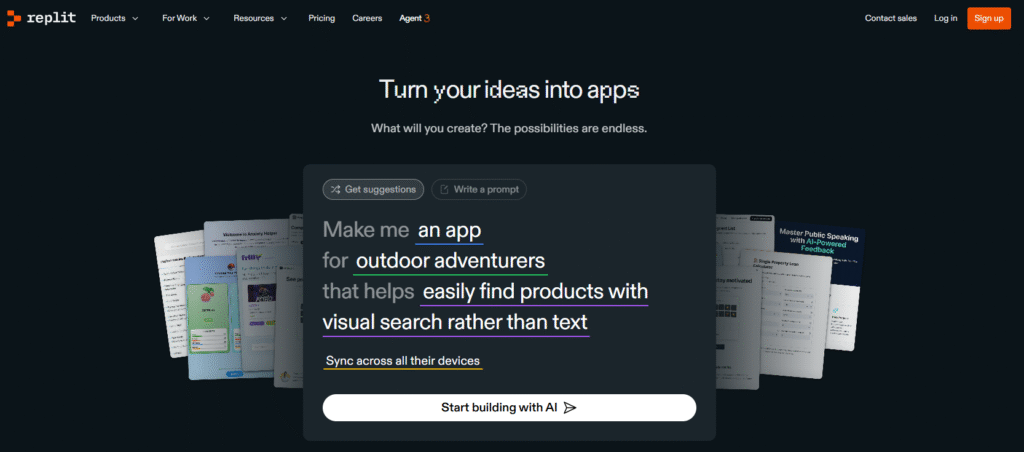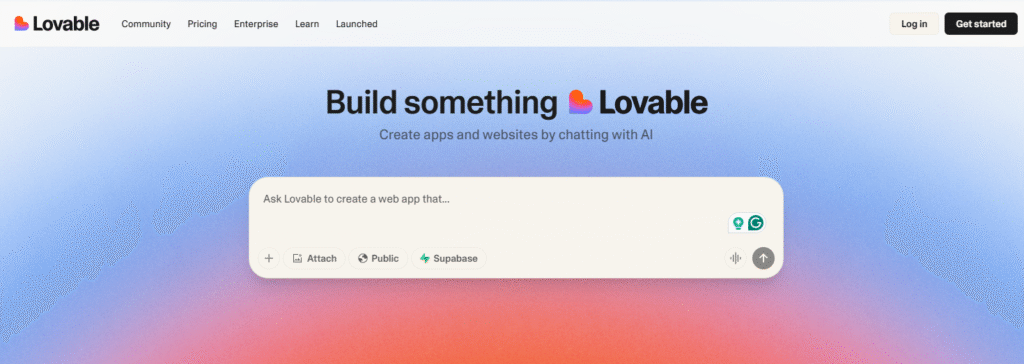When it comes to AI-powered development tools, two platforms stand out from the crowd: Replit and Lovable AI. Both promise to revolutionize how we build software, but they approach this mission from completely different angles.
Whether you’re a seasoned developer or a non-technical founder, understanding the Replit vs Lovable dynamic could significantly impact your workflow.
This comprehensive comparison will help you determine which AI APP platform deserves your attention (and potentially your subscription dollars) in today’s competitive landscape.
What is Replit?

Think of Replit as your ultimate coding playground in the cloud—an all-in-one platform that combines a collaborative IDE, robust deployment pipelines, and cutting-edge AI assistance right in your web browser. It’s where simplicity meets serious coding power, making it a favorite among everyone from students learning their first programming language to experienced developers building full-stack applications.
Replit’s secret weapon is Ghostwriter, its integrated AI assistant that acts like a super-powered pair programmer. This intelligent companion constantly suggests code, fixes bugs, and even explains complex functions in plain English. The platform’s philosophy isn’t to replace traditional coding but to enhance it—making the process of writing code faster, more collaborative, and more accessible to everyone.
Replit Key Features
Cloud-Based IDE Experience
Replit eliminates the dreaded “it works on my machine” problem by providing a complete development environment in your browser. You can write, run, and debug code without any local setup or configuration headaches. This pure, instant coding approach means you can go from idea to execution in seconds, not hours.
Ghostwriter AI Suite: Your Coding Companion
This isn’t just fancy autocomplete. Ghostwriter offers context-aware code suggestions and can generate entire functions from simple descriptions. It explains complex code snippets, helps optimize existing functions, and proactively identifies potential bugs with real-time fixes. It’s like having an experienced developer looking over your shoulder, ready to help at any moment.
Seamless Deployment and Collaboration
Reployments (Replit’s integrated hosting) lets you ship your apps instantly using their scalable infrastructure. The Multiplayer mode enables real-time collaborative editing similar to Google Docs for code—perfect for team projects or educational environments. Plus, the Bounties marketplace lets you monetize your skills by solving real-world coding problems.
Massive Language Support
With support for over 50 programming languages—from Python and Node.js to Rust and C++—Replit truly caters to developers of all backgrounds and specialties.
What is Lovable AI?

Lovable AI represents the new wave of AI-first development tools, making significant waves in the app generation category. Unlike traditional IDEs, Lovable operates through a prompt-based UI builder powered by advanced language models. Its core mission is to eliminate the time gap between having an idea and seeing a visual, working prototype.
Lovable isn’t primarily about writing perfect code—it’s about generating visually polished, functional frontends immediately. Imagine a tool that combines the design capabilities of Figma with the conversational power of ChatGPT, focused exclusively on front-end delivery. This approach empowers non-technical users—founders, product managers, and designers—to build and iterate interfaces without writing a single line of code.
Lovable AI Key Features
Prompt-to-UI Generation Magic
Describe your application interface in plain English (try “A CRM app with contacts page, table view, and dark mode toggle”), and Lovable instantly generates a fully designed, functional interface. This magical transformation happens in seconds, not days.
AI-Powered Iteration and Refinement
The conversation doesn’t stop after the initial generation. Lovable allows continuous refinement through simple text prompts. The AI understands context, enabling highly iterative, conversational design tweaks that feel natural and intuitive.
Figma-Style Customization
Despite being AI-generated, the interfaces use real, customizable components (buttons, modals, tables) that support drag-and-drop editing. You get the polish of a professionally designed interface with the flexibility to make it your own.
Component-Aware Architecture
Lovable generates UIs using industry-standard components, ensuring your prototype can smoothly transition into a developer’s workflow when you’re ready to scale.
Collaborative Design Canvas
Easily share and iterate on UI prototypes with your team or stakeholders for rapid feedback and alignment. The platform understands that great products emerge from collaboration, not isolation.
Supabase Integration
While focused on front-end delivery, Lovable offers seamless integration with Supabase for backend services, making it easy to connect your beautiful interface with real data and authentication logic.
Replit vs Lovable: Features Comparison Showdown
The real difference between these platforms extends beyond their feature lists to their fundamental philosophies about development workflows and who should be building software.
1. Speed vs Structure
Lovable AI dominates rapid visual prototyping by focusing intensely on front-end interfaces. It can deliver a visually complete, functional UI from a simple prompt in seconds—perfect for building MVPs quickly, especially those prioritizing user experience. The outputs are presentation-ready immediately, requiring no additional polishing.
Replit takes a more comprehensive approach, handling both front-end and back-end development within a versatile environment. While still fast, its initial generation emphasizes establishing solid code structure and full-stack architecture first. The visual polish often requires additional refinement through Ghostwriter or manual coding, but you get a more complete foundation for complex applications.
The verdict: Lovable wins for visual speed; Replit wins for architectural completeness.
2. AI Responsiveness
Both platforms boast impressive low-latency suggestion generation, but they cater to different audiences with distinct needs.
Lovable’s AI excels at understanding non-technical users. Its conversational model effectively translates vague prompts like “make this button bigger and blue” into desired results, effectively rescuing users from “prompt purgatory.” It speaks the language of design and user experience.
Replit’s Ghostwriter proves more valuable for users with coding backgrounds. It understands function signatures, variable names, and code context deeply, allowing developers to move faster, write less boilerplate, and receive accurate, context-aware suggestions for complex logic. It speaks the language of code.
The verdict: Lovable translates for founders and designers; Replit accelerates developers.
3. Editing Philosophy
This distinction determines your level of control and the learning curve you’ll face.
Lovable champions visual-first, accessibility-first editing. You see the interface, you tweak the interface, and the code remains secondary. This dramatically lowers the entry barrier but naturally limits customization depth. For highly advanced or non-standard logic, you might encounter limitations.
Replit maintains a code-first workflow enhanced by AI support. You get full access to well-structured file management and robust framework support (Flask, Vanilla JS, etc.). This balance proves essential for building complex, production-ready applications where logic and deep customization matter most. The AI helps write code, but the code remains the source of truth.
The verdict: Lovable for intuitive, high-speed iteration; Replit for full control and complex project management.
4. Educational Approach
Both platforms utilize split-screen interfaces (AI chat on left, code/preview on right), but their educational philosophies differ significantly.
Replit’s Ghostwriter acts as a developer’s assistant, focusing on helping you build features quickly while explaining the code it writes. The goal transforms text descriptions into functional applications while making you a better coder in the process.
Lovable’s AI serves as a beginner’s guide, automating front-end building while requiring minimal coding experience. It often focuses on helping non-technical users understand basic structure and concepts behind their generated interfaces.
The verdict: Replit’s AI teaches you how to code; Lovable’s AI teaches you what an app is.
Replit vs Lovable: Pricing Models Compared
Choosing a platform means understanding how pricing scales with your needs. Are you paying for developers (seats) or AI assistance (usage/credits)?
Replit Pricing Structure
- Replit Core ($25/month): Make, launch, and scale your apps.
- Teams ($40 per user per month): Bring the power of Replit to your entire team.
- Enterprise: Meet your security and performance needs.
Lovable AI Pricing Structure
- Pro ($25/month): Designed for fast-moving teams building together in real time.
- Business ($50/month): Advanced controls and power features for growing departments.
- Enterprise: Built for large orgs needing flexibility, scale, and governance.
Final Thoughts on Replit vs Lovable
In today’s AI development landscape, the choice between Replit and Lovable represents a choice between two distinct philosophical approaches to building software. Both platforms deliver impressive acceleration to development processes, but they cater to fundamentally different priorities and user types.
Your decision ultimately depends on where you sit in the development process and what you’re trying to accomplish. The best news? You might not need to choose exclusively, as many teams find value in using both tools at different stages of their product development lifecycle.



